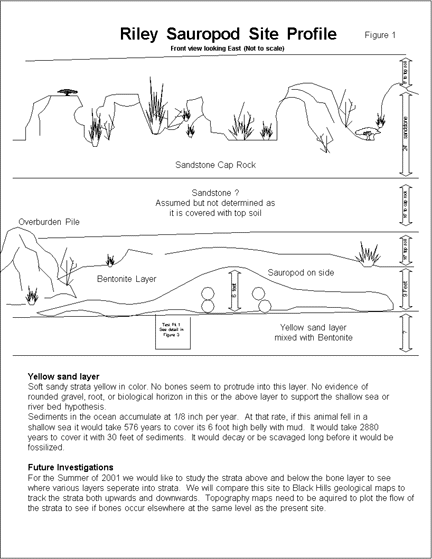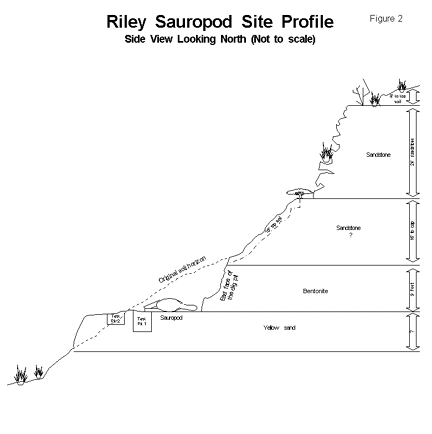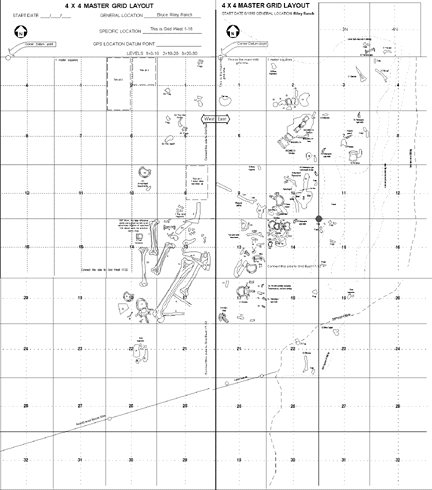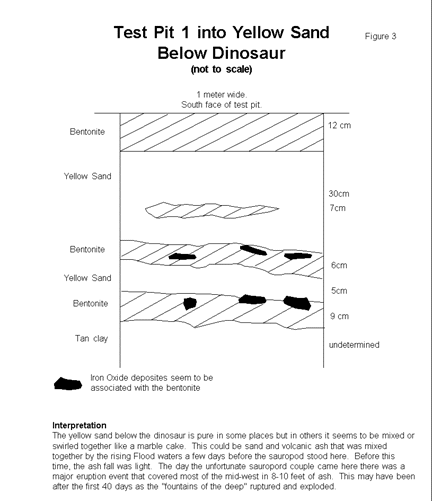








|

Adventure Safaris
Report on the Bruce Riley Dinosaur Site, Summer 2000
By Russ McGlenn
For Pictures of the Summer 2000 Dig, Click HERE.
The Specimens at the Site
The dinosaurs worked on were sauropods, often called the "Long Neck." Previous excavators had identified them as apatosaurus. The dig site has been worked by others in the last 3 years. During the 1999 dig season, one tooth was found that seemed to match the sauropod species or variety Tannanasaurus (Specimen #BRG17NEL1S3, The Dinosauria, Univ. of California Press, 1990, tooth Sauropoda, Yunnanosaurus, p. 325). A second tooth was found similar to a Dromeosaurus. These were the first teeth found that might identify the animals. Both teeth need further study for a positive identification. Eight vertebrae were found; one appears to be a cranial dorsal vertebrae (Specimen #BRG17NEL1S1, The Dinosauria, p. 361) in good condition. The number of leg bones found indicate at least two sauropods are buried at the site. Three hypotheses attempt to explain how these animals got to the site and died.
Site Hypothesis One
This hypothesis states that the sauropod bodies were washed in and deposited here by a local flooding river. Over many years, more local floods brought in additional sediment until 10 to 15 feet accumulated. Then, over millions of years, their bones were replaced by minerals to reach their present fossilized state. Based upon river action seen today, this hypothesis would expect to see washed-in material with the dinosaurs, such as leaves, twigs, branches, unsorted gravel, and sand. Other than three tiny shells in one corner, the site was very clean. Underneath the dinosaurs was a tan or yellow sand layer, and they were covered with volcanic ash (bentonite). Above the ash were several layers of sandstone, but no flood debris was found in the excavation (figures 1 and 2).
Site Hypothesis Two
This hypothesis states that the dinosaurs were living near a shallow inland sea, died, and were slowly buried by the sea over millions of years, similar to the above hypothesis. The dig site data does not support this for four reasons:
1. Today, sediments collect on the bottom of the ocean at the rate of about one-eighth inch per year. The dinosaur, lying on its side, was approximately 6-feet high. At the rate of one eighth inch per year, sediment would take 576 years to reach the height of the body, and 1152 years to accumulate another 12 feet. As can be seen, the bones and body would have rotted or been scavenged by other animals long before the fossilization process could begin. To fossilize, a specimen must be buried quickly and deeply: quickly to prevent scavenging by other animals, and deeply to stop aerobic bacterial action from decomposing the flesh and bones. This is similar to a cat or dog buried in the backyard in 16 to 18 inches of dirt. Within a few years, not even the bones are left, having been broken down by the aerobic action.
2. Other than the three clam shells and one belemnite, none of the fossils present would indicate a shallow sea. This is an open question as marine fossils have been found in strata above and below this site. More investigation needs to be done on this point.
3. Trackways found locally in South Dakota and Wyoming, along with thousands throughout the Midwest, indicate these animals were not grazing but were fleeing some catastrophic event.
4. Coprolite is the name given to fossilized dinosaur dung. Much has been found in the Badlands. To fossilize, this must be buried almost immediately, or it will be washed away by rain or decompose on the surface in a few days. If dung is deposited in a shallow sea, marine organisms will dispose of it long before it can fossilize. Only a flood carrying massive amounts of sediments could bury it quickly and deeply enough to form coprolite.
Site Hypothesis Three (Figures 1, 2, 3)

For a larger version of this figure, click HERE

For a larger version of this figure, click HERE

For a larger version of this figure, click HERE
For cone-down views on parts of the site, click HERE and HERE.
The third hypothesis states that the dinosaurs, fleeing rising flood waters, paused here at a rise in the land as the high tides came in (every 12 hours) covering the lower land. While they waited for the waters to recede, volcanoes to the West exploded, and ash rained down on them. They suffocated, rolled on their sides, and were covered by 6 to 10 feet of ash. When the next silt-laden tide came in, another 6-foot layer of sediments was deposited on top of the ash. The ash was pressed down to become bentonite, and in time the dinosaurs fossilize.
This hypothesis explains that the dinosaurs were fleeing the rising Flood waters during the first 150 days of Noah's Flood. As recorded in Genesis chapter 7, the hard rains of the first 40 days eroded away much of the mountains. Then for 110 days (about 4 months) the waters continued to rise until the highest mountains were covered by 20 feet of water. Most of the fossilized animals died during this 150-day period. The sauropods at this site, who may have been mates, had made it to high ground before the returning tidal waters (on a 12 hour cycle) covered the low ground. While they waited for the tide to go out so they could continue north to safer ground, volcanic ash from the Rocky Mountains began to fall. There were probably hundreds of volcanoes along the Rockies belching out billions of tons of ash, covering the Midwest in a 5 to 10 foot layer, according to today's geological records in Wyoming, Montana, Kansas, and North and South Dakotas.
This could be what the Bibles refers to when it says the "fountains of the deep erupted." These fountains may have been volcanoes spewing out ash and poisonous gases, along with water vapor that would condense and cause "gully washer" rains. As the ash fell on the sauropods, they suffocated and fell on their sides. When the next tide came in laden with silt and shell parts from some other "biological neighborhood," these shells were deposited near the sauropods, where they were found nearly 4000 years after the event. Here is some data that supports this hypothesis.
1. The "biological neighborhood" principle states that animals and plants living together are frequently buried together (Figures 4 and 5).

For a larger version of this figure, click HERE

For a larger version of this figure, click HERE
Dinosaurs tend to be buried together, apart from mammals, because the two seldom associated. At this site, this remains true, similar to the Dragons Graveyard near Newcastle, WY, where thousands of hadrosaurs, triceratops, and other dinosaurs are buried together. The White River fossil beds, just south of the Black Hills, contain predominately mammals. This is a biological neighborhood populated by mammals; just as today we find no bears in Africa, we find no dinosaurs in the White River strata.
2. Mine engineers say this area's bentonite has a high sodium content and is some of the finest in the world. The high sodium content is a result of mixing with salt water. The waters of Noah's Flood would have been ideal for this, being loaded with mineral salts picked up during the 40 days of rainfall when billions of tons of soil and minerals washed into the sea.
3. A second kind of flood activity is called "flood mixing." In this situation, specimens from one biological neighborhood are carried by flood waters into another neighborhood. The presence of marine clam shells in the bentonite next to the dinosaurs indicate flood mixing. Though flora and fauna are generally buried in biological neighborhoods, there are always exceptions. These anomalies can be explained by flood waters carrying marine life from further south and depositing it with the dinosaurs near the time of their deaths. The evolutionary explanation is that these shells were washed out of another strata and redeposited with these animals. However, since they are surrounded by bentonite matrix, this explanation does not work.
4. Three years ago, a site in southwestern North Dakota yielded a similar example: a marine stingray tooth found with a hadrosaurus.
5. Palm tree stumps have been found north of the site, as well as clam shells and belemnites on the ranch across the highway to the north of the dig site. The palm stump would indicate a tropical biological neighborhood. This would not be in keeping with the climate now. The Flood hypothesis states that before the Flood, the whole earth was semi-tropical. This palm stump provides evidence of this pre-flood climate.
Conclusion
In the first two hypotheses, the absence of river debris and vegetation for grazing rules out these theories, being unable to explain the data (in this case the lack of data). The site is pristinely clear of anything indicating the presence of either an inland sea or a riverbed. The evidence points to the third hypothesis as fitting the data better. The marine fossils in the area can be accounted for by flood mixing. Next summer, we hope to flesh out the Flood hypothesis by expanding our search area to classify and explore the strata above and below the dinosaur site (see illustration figure 1).
|